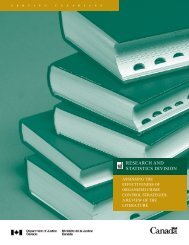National Threat Assessment 2008. Organised Crime - Politie
National Threat Assessment 2008. Organised Crime - Politie
National Threat Assessment 2008. Organised Crime - Politie
You also want an ePaper? Increase the reach of your titles
YUMPU automatically turns print PDFs into web optimized ePapers that Google loves.
those used for scrap vehicles. A lot of E-waste also ends up in Asian countries.<br />
One frequently used transport method involves loading up scrap vehicles with<br />
E-waste to combine the two waste streams.<br />
Hazardous waste materials<br />
It has been known for some time that Africa is regularly used as a dump site.<br />
A study carried out for the United Nations back in 2000, for example, described<br />
incidents relating to the importing of hazardous waste materials into African<br />
and Asian countries in 1993 and 1994. Most of the offenders were Nigerian<br />
businessmen. The most widely used method to prevent the discovery of the<br />
illegal activities was to mislabel the waste materials. The offenders tried to evade<br />
inspections by pretending that the materials were raw materials or components<br />
with a positive economic value.<br />
Since the 1990s China has also been the destination for various shipments of<br />
hazardous waste. Research by Greenpeace shows that most of these shipments<br />
come from industrialised (OECD) countries. In many cases, however, the exporter<br />
or intermediary can no longer be traced, often because the ‘companies’ involved<br />
turn out to have only a PO box address. As a consequence the costs of returning<br />
and processing the waste must be borne by the national government. In the late<br />
1990s the Philippines and Indonesia imported a lot of waste metal from batteries<br />
(with permission from the authorities). In many cases this was supposedly for<br />
recycling purposes, but it turned out that the quality of the processing plants<br />
was insufficient. The result was that much of the waste was dumped on<br />
mountains of domestic waste.<br />
It is striking that the legal stream of a particular type of waste can follow<br />
a different route from the illegal stream of the same waste material. Fridges<br />
and E-waste are two good examples: the legal stream stays within the European<br />
Union, whilst illegal transports end up in Africa and East Asia.<br />
The VROM Inspectorate has discovered that a lot of violations of the export<br />
ban are linked to the port of Amsterdam. These violations involve the export<br />
of waste materials such as computer components, televisions and scrap vehicles<br />
to Africa, countries in the Caribbean and islands in the Pacific. Electronic<br />
equipment is often loaded into used or scrap vehicles.<br />
3.5.5 Consequences for Dutch society<br />
The negative consequences of cross-border waste streams are mainly in the<br />
destination countries, where damage to the environment and public health<br />
126 <strong>National</strong> <strong>Threat</strong> <strong>Assessment</strong> 2008 – <strong>Organised</strong> crime








